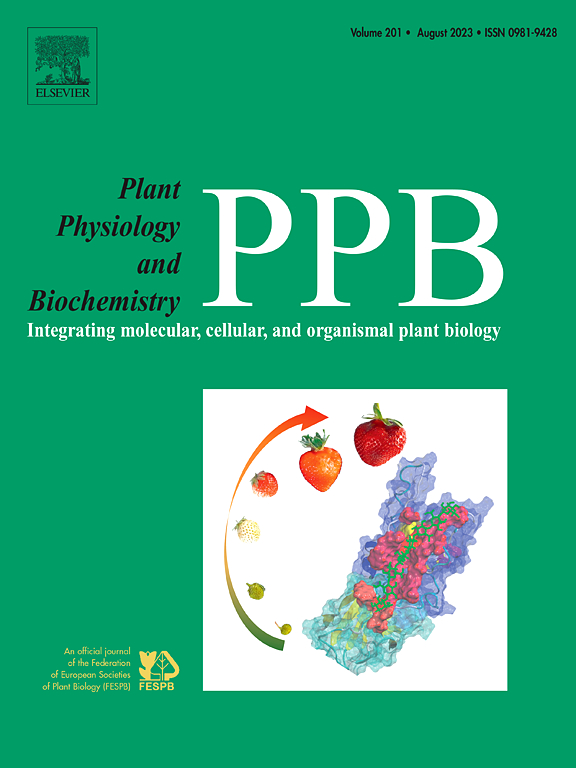Transcriptomic and phytohormonal profiling of the adventitious shoot regeneration of Camellia reticulata and functional characterization of the CrSAUR20 gene
IF 5.7
2区 生物学
Q1 PLANT SCIENCES
引用次数: 0
Abstract
In establishing in vitro regeneration of Camellia reticulata, we found that the callus from the wild C. reticulata plant could differentiate into the adventitious shoot (AS). In contrast, the callus from C. reticulata cultivar ‘Purple Gown’ has not yet differentiated into the AS, and the mechanism of AS regeneration was still unclear. The molecular mechanisms underlying AS regeneration were investigated using transcriptomic profiling and phytohormone quantification. Results showed that the levels of cytokinin, auxin, and other hormones in the callus of the wild C. reticulata plant were significantly changed compared with those of ‘Purple Gown’. Transcriptomic profiling identified differentially expressed genes (DEGs) involved in phytohormone signaling and hormone biosynthesis pathways. Among these, the expression of response regulators (ARRs), auxin response factors (ARFs), indole-3-pyruvate monooxygenase (YUCCAs), small auxin up-regulated RNAs (SAURs), ethylene-responsive transcription factor 1/2 (ERF1/2), and others significantly differed between the wild C. reticulata plant and ‘Purple Gown’, affecting the development of AS in the callus of the C. reticulata. To further validate the gene function related to hormones, CrSAUR20 was cloned as an example and its overexpression vector was constructed. The overexpression of CrSAUR20 promoted an increased ratio of auxin-to-cytokinin in transgenic tobacco plants and affected the differentiation of AS and root from the leaf disc of transgenic tobacco plants, suggesting a positive regulatory role of CrSAUR20 in auxin signaling transduction. Genotype, phytohormone ratio, and phytohormone crosstalk were critical factors in enhancing AS regeneration capacity in the callus of C. reticulata.
茶树不定芽再生的转录组学和植物激素分析及CrSAUR20基因的功能表征
在建立山茶离体再生的实验中,我们发现野生山茶愈伤组织可以分化为不定芽(AS)。而紫袍愈伤组织尚未分化为AS,其再生机制尚不清楚。利用转录组学分析和植物激素定量分析研究了AS再生的分子机制。结果表明,野生网麻愈伤组织中细胞分裂素、生长素等激素水平与紫袍相比发生了显著变化。转录组学分析鉴定了参与植物激素信号和激素生物合成途径的差异表达基因(DEGs)。其中,生长素应答因子(ARRs)、生长素应答因子(ARFs)、吲哚-3-丙酮酸单加氧酶(YUCCAs)、生长素小分子上调rna (SAURs)、乙烯应答转录因子1/2 (ERF1/2)等的表达在野生藤和紫袍之间存在显著差异,影响了紫袍愈伤组织AS的发育。为了进一步验证与激素相关的基因功能,以CrSAUR20为例进行克隆,构建其过表达载体。CrSAUR20的过表达促进了转基因烟草中生长素与细胞分裂素的比值增加,影响了转基因烟草叶片向AS和根的分化,提示CrSAUR20在生长素信号转导中具有正向调节作用。基因型、激素比和激素串扰是提高网柏愈伤组织AS再生能力的关键因素。
本文章由计算机程序翻译,如有差异,请以英文原文为准。
求助全文
约1分钟内获得全文
求助全文
来源期刊
CiteScore
11.10
自引率
3.10%
发文量
410
审稿时长
33 days
期刊介绍:
Plant Physiology and Biochemistry publishes original theoretical, experimental and technical contributions in the various fields of plant physiology (biochemistry, physiology, structure, genetics, plant-microbe interactions, etc.) at diverse levels of integration (molecular, subcellular, cellular, organ, whole plant, environmental). Opinions expressed in the journal are the sole responsibility of the authors and publication does not imply the editors'' agreement.
Manuscripts describing molecular-genetic and/or gene expression data that are not integrated with biochemical analysis and/or actual measurements of plant physiological processes are not suitable for PPB. Also "Omics" studies (transcriptomics, proteomics, metabolomics, etc.) reporting descriptive analysis without an element of functional validation assays, will not be considered. Similarly, applied agronomic or phytochemical studies that generate no new, fundamental insights in plant physiological and/or biochemical processes are not suitable for publication in PPB.
Plant Physiology and Biochemistry publishes several types of articles: Reviews, Papers and Short Papers. Articles for Reviews are either invited by the editor or proposed by the authors for the editor''s prior agreement. Reviews should not exceed 40 typewritten pages and Short Papers no more than approximately 8 typewritten pages. The fundamental character of Plant Physiology and Biochemistry remains that of a journal for original results.

 求助内容:
求助内容: 应助结果提醒方式:
应助结果提醒方式:


